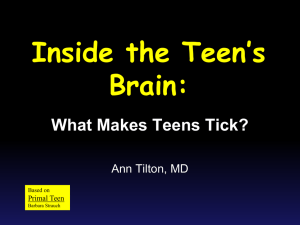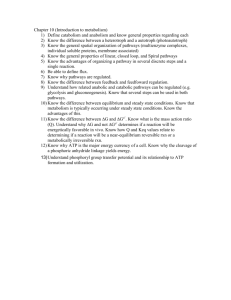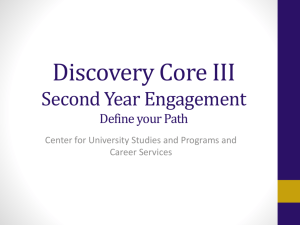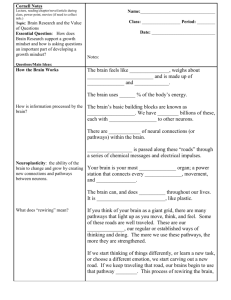brainsystems_9_5_ml
advertisement
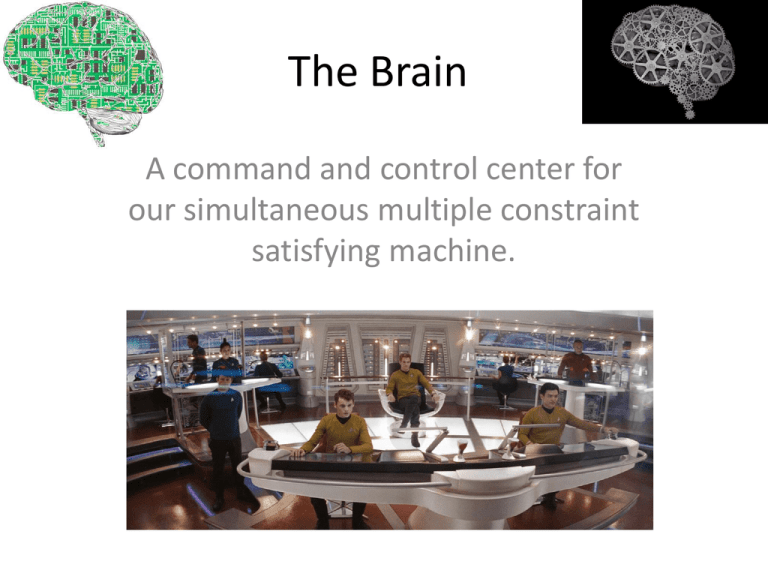
The Brain A command and control center for our simultaneous multiple constraint satisfying machine. Outline • • • • • • • • • Staying alive and maintaining Homeostasis Perception Motivation and Effort Emotions & Habits Decision Making Movement and Procedural Learning Memory Language Methods for studying the brain Having a Brain is Evolutionarily Conserved The Brain Stem (staying alive) Thalamus Structure: X-Ray View What and where pathways of vision Structure: X-Ray View Hypothalamus: Homeostasis meets Consciousness (Sleep and Hunger) See Kens lecture 8/29 slide 18 Drive to eat: HPA (hypothalamus-pituitary- adrenal) axis (stress), Dopamine (motivation), Memory ( food location), Cannabinoids (munchies) Motivation and Allocation of Effort Motivation and Allocation of Effort Motivation Pathways Two Dopamine (DA) pathways drive a variety of activity: • Emotions • Habits • Decisions • Risk assessment • Movement • Memory Emotions & Habits Orbital frontal cortex (OFC) Motivation Pathways Two Dopamine (DA) pathways drive a variety of activity: • Emotions • Habits • Decisions • Risk assessment • Movement • Memory Decision Making and Risk Case Study: Phineas Gage Motivation Pathways Two Dopamine (DA) pathways drive a variety of activity: • Emotions • Habits • Decisions • Risk assessment • Movement • Memory Movement • Representation - Where is the body? • Planning - Where and how should it all be moved? • Execution - Just do it. Fixed action patterns vs Planning • Feedback - Do it correctly and do it better next time. Body representation: Homunculus Map of Human Cortex Homunculus Map of Human Cortex Motor Planning Parietal Cortex Basal Ganglia: Procedural Learning and motor Output Seger & Miller (2010) 22 Cerebellum and Prediction Errors Thalamus Apraxias • Difficulty in carrying out purposeful movements without the loss of muscle strength or coordination – Disconnection between primary and nonprimary motor areas – Able to carry out each part of a complex movement, but disruption lies in coordination of the movements Motivation Pathways Two Dopamine (DA) pathways drive a variety of activity: • Emotions • Habits • Decisions • Risk assessment • Movement • Memory Hippocampus: Explicit Memory Binding problem • Hippocampus seems to do it but how? Place cells in hippocampus HM: Life without a Hippocampus Language: Beyond Dopamine. Aphasias • Broca’s Aphasia: disturbance in speech production, caused by damage to Broca’s area – Patient video • Agrammaticism • Anomia • Difficulty with articulation • Wernicke’s Aphasia: disturbance in speech comprehension, caused by damage to Wernicke’s area – Patient video • Disruption in recognition of spoken words • Disruption in comprehension of the meaning of words • Inability to convert thought into words Aphasias Summary of neuro systems • Multiple systems in the brain. • Simultaneous interactions between systems. • Relays between areas that process information and areas that integrate that information. • Behavior is the result of functional specialization of processing in a distributed network. • The work is complicated and ongoing Methods for studying the brain • Single-cell and population recordings – Animal studies – Surgical patient studies – EEG • Stimulation – Animal studies – Surgical patient studies – TMS, tDCS • Damage – Animal lesions – Human injury – Human surgical lesions • Neuroimaging – Structural analysis, fMRI, DTI, MEG • Genetics • Electroencephalogram (EEG) recording – Electrodes are placed on the surface of the scalp and record/amplify the electrical signal given off by the brain – Event Related Potentials (ERPs) are used to study how the brain responds to different stimuli or events CT scan MRI scan Functional Magnetic Resonance Imagingin (fMRI) – Measures changes in blood-oxygenlevel-dependent (BOLD) activation – Areas of the brain that are engaged more in a task, require oxygen rich blood – Result show a very small but highly significant percent change in BOLD activation (the entire brain is active all the time) Connectivity measures Functional connectivity – uses resting-state fMRI data to chart cortical regions with temporal synchrony (correlation of activation patterns) Structural connectivity – measures the movement of water molecules to chart the white matter tracts (visualizing anatomy) Diffusion Tensor Imaging (DTI) Diffusion Spectrum Imaging (DSI) Brain Review- concepts -cephalization -CNS vs peripheral -sensory input and motor output -homunculus (topography and distortions of input) -Dopamine and motivation (prediction) -contralateral innervation -neurons! -all or none (rate coding) -doctrine of nerve energies -Structure and function are all tied up together. Brain areas to know • Hindbrain (brainstem) • Hypothalamus!! – Pituitary gland, sleep, motivations (eating) • Thalamus (relay) • Limbic (emotional valence) • Cortex (lobes) • Occipital (what/where/visual hemi fields on opposite sides) • Language (left lateralized) • Somatosensory vs motor planning (homunculus) • Parietal (where) • Temporal (what) • Executive control (frontal lobe) • Hippocampus (explicit memory & place cells) • Basal ganglia (procedural memory) Damage- structure related to function • • • • • • • • Split brain –corpus callosum Phineas gage – frontal damage HM - hippocampus Aphaisas brocca and wernikes –language circuits brocca(output) wernikes (input) Apraxias –motor planning and body sensation disconnect Visual agnosias – inability to see something (prosapagnosia -face blindness) Hypothalamus –FAT rats Autism – failure of connections to form? Brain Structure What does the homunculus tell us? • Localization of motor and sensory function • Topographical organization • Cortical representation related to function not mass Split Brain
